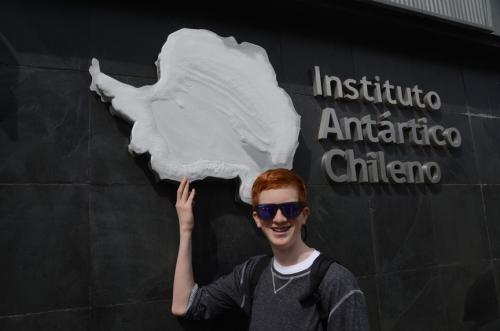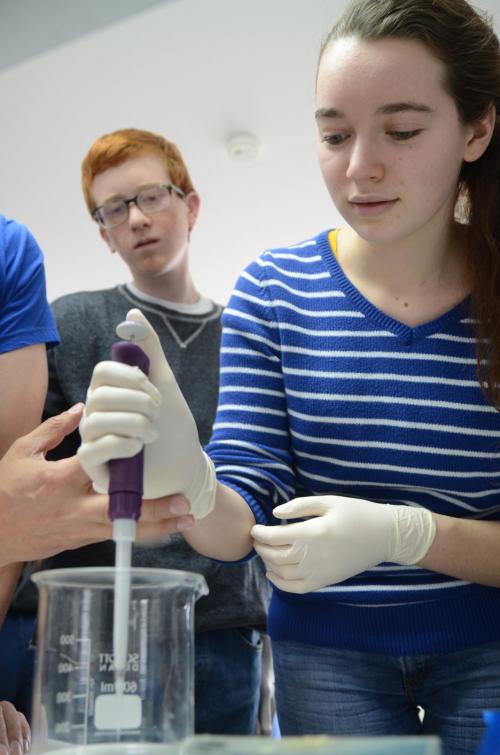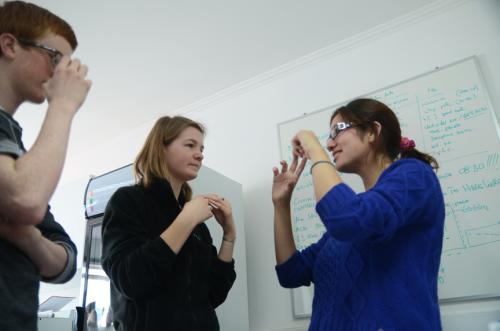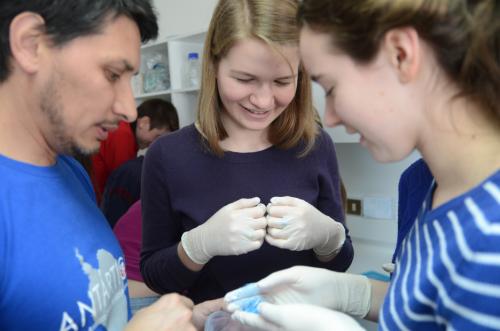We have a description of what happened before we were aware that Luke and others were sick today.
The bus took us to a new venue this afternoon; instead of the INACH building, we were at the INACH laboratory a few blocks away. There, we began our studies of Antarctic plant life.
 Luke at INACH's bacán (cool) entrance. They have a metal cutout of Antarctica connected to a compressor in the back. The metal freezes and the water in the air condenses, creating a frozen Antarctica symbol.
Luke at INACH's bacán (cool) entrance. They have a metal cutout of Antarctica connected to a compressor in the back. The metal freezes and the water in the air condenses, creating a frozen Antarctica symbol.
First, we got a quick tour of the building. There were rooms filled with equipment I have no idea how to use - not yet, at least. On one of our stops, our guide explained some of the research they're doing there with Antarctic bacteria. What I gathered is that some bacteria (found in Antarctica) produce certain proteins that protect them from other bacteria. This means that these proteins are basically naturally occurring antibiotics. The scientists at INACH are working with these bacteria to try to develop better antibiotics that might be put to uses such as preserving meat or sanitizing doctors' hands.
I find this sort of creative thinking extremely interesting. Scientists are taking what they see in nature and finding ways to learn from it and solve problems. I don't know much about the scientific advances that have been made in this way, but it seems like a unique and promising way to see the world. If another human knows something better than we do, we ask them about it and learn from them. Why not do the same with other organisms? To me, studying and learning from plants and animals seems like an intriguing and exciting field of study that provides countless opportunities for scientific advances.
After our tour, we listened to an informational talk about the proteins we were going to be studying, and then we proceeded up to the lab to try it all for ourselves. We divided into groups to try out two different ways to detect these proteins. The proteins we looked at are called cryoproteins, and they are found inside the cells of Antarctic plants. Their job is to stabilize the cells and prevent the plant from freezing.
My experience in the lab today was exciting yet challenging in a lot of ways. Before today, I had only worked in our lab areas at school, never in a lab like at INACH. I felt like I was entering a whole new universe, one where everyone knows how to use a micropipette and what 'electrophoresis' is. This is an area of science I don't have much experience in, which got me thinking and curious about the countless things a person could possibly spend his or her life studying.
Feeling like I had traveled to another universe also made the experience somewhat challenging. I was more or less starting from scratch, so the researcher we were working with got me a beaker of water to practice my micropipette-ing skills. Even though I had no idea what I was doing at first, it was definitely exciting to be using the equipment for the first time.
 Anna practicing using the micropipette at INACH's laboratories.
Anna practicing using the micropipette at INACH's laboratories.
I also had to struggle with understanding the concepts of the lab after hearing them explained in Spanish. Our work involved things that I would have had lots of questions about in English, so grasping it in Spanish was quite challenging. Fortunately, one of our group mates was Anna's and my roommate, Reynalda. She is extremely helpful and passionate about science, and she was completely willing to explain anything to me in either language. Between Reynalda and Juan, I managed to get most of my questions answered, and I ended up learning quite a bit about the lab processes we were using to detect the proteins.
 Reynalda helped us understand the science in Spanish. From left to right, Luke, Claire and Reynalda.
Reynalda helped us understand the science in Spanish. From left to right, Luke, Claire and Reynalda.
Although being given semi-complicated instructions and information in Spanish made my head spin, it was really satisfying when I would finally understand a technique or get an answer to one of my questions. I hope some of the knowledge I gained today finds its way into my future career, because I will never forget learning about microbiology and micropipettes in a laboratory in Chile.
 Jorge showed us the results of the electrophoresis we did at INACH to separate proteins according to their size. From left, Jorge Gallardo from INACH, Claire and Anna
Jorge showed us the results of the electrophoresis we did at INACH to separate proteins according to their size. From left, Jorge Gallardo from INACH, Claire and Anna
